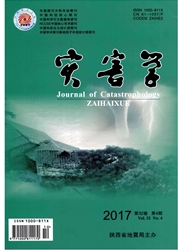

 中文摘要:
中文摘要:
由暴雨引起的山洪灾害、城市洪涝灾害在我国频繁发生,造成严重人员伤亡。因此研究洪水作用下的人体稳定性条件,能为洪泛区规划、城市防洪标准制定提供科学参考。以往提出的人体稳定性条件,通常忽略人体所受浮力作用并假定来流沿水深均匀分布,因此有必要进一步开展洪水中人体稳定性条件的理论分析及试验研究。该文首先分析了洪水中人体的受力特点,根据人体结构特点计算不同水深下人体所受的浮力,同时结合河流动力学中泥沙起动的理论,推导出洪水中人体发生滑移及跌倒失稳时的起动流速公式;然后采用一小比尺的人体模型开展一系列的水槽试验,得到不同失稳及水深条件下人体的起动流速,用于率定公式中的相关参数,同时采用模型比尺关系及率定后的计算公式分别估算人体原型在不同水深下的失稳条件;最后采用已有真实人体的水槽试验结果重新率定人体滑移及跌倒失稳时的参数,结合人体模型的试验成果,给出了儿童及成人在不同来流条件下的失稳区间。基于真实人体试验的率定结果因考虑了人体在洪水中能逐渐调整站姿适应来流的过程,故结果偏于危险,而本文模型试验的率定结果偏于安全。
 英文摘要:
英文摘要:
Flash floods and urban floods due to heavy rain occurred frequently in China, causing considerable loss of life. The investigation of criterion of human stability in floodwaters can provide scientific reference to flood- plain area planning and urban flood control standards. However, existing criteria of human stability usually neglect the effects of body buoyance and non-uniform velocity profile of incoming flow. Therefore, it is necessary to conduct the research into an appropriate criterion of human stability in floodwaters, using theoretical and experimental stud- ies. In the current study, different forces acting on a human subject have been analyzed, with the corresponding expressions for these forces being presented, and with the formulae of incipient velocity being derived respectively based on two different instability mechanisms. More than 50 runs of flume experiments were then conducted to ob- tain the conditions of water depth and corresponding velocity at human instability, under two instability mechanisms of toppling and sliding, using a vivid scaled model human body. The experimental data from these studies were then used to determine two parameters in the derived formula for each instability mechanism, and the incipient ve- locities under different incoming depths for the prototype of human body were estimated using the scale ratios and the calibrated formulae. Finally, the derived formulae at the modes of sliding and toppling were re-calibrated in de- tails by the experimental data using real human subjects. Toppling stability thresholds for children and adults have been proposed in this study, based on the calibrated results obtained using the different sets of experimental data. The stability thresholds calibrated for the real human subjects tend to be more dangerous, as compared with the sta- bility thresholds using the model human body, because the former accounts for the ability of the test subject to ad- just to the standing posture according to the inflow conditions and to redirect t
 同期刊论文项目
同期刊论文项目
 同项目期刊论文
同项目期刊论文
 期刊信息
期刊信息
